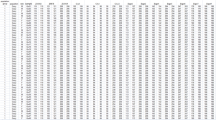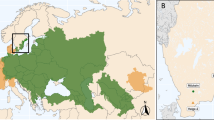Abstract
LENGTH polymorphisms within simple-sequence loci occur ubiquitously in non-coding eukaryotic DNA and can be highly informative in the analysis of natural populations1–4. Simple-sequence length polymorphisms (SSLP) in the long-finned pilot whale Globicephala melas (Delphinidae) have provided useful information on the mating system as well as on the genetic structure of populations5. We have therefore tested whether the polymerase chain reaction primers designed for Globicephala could also be used to uncover variability in other whale species. Homologous loci could indeed be amplified from a divers range of whales, including all toothed (Odontoceti) and baleen whales (Mysticeti) tested. Cloning and sequencing these loci from 11 different species revealed an unusually high conservation of sequences flanking the simple-sequence stretches, averaging 3.2% difference over 35–40 Myr. This represents the lowest divergence rate for neutral nucleotide positions found for any species group so far and raises the possible need for a re-evaluation of the age of the modern whales. On the other hand, the high conservation of non-coding sequences in whales simplifies the application of SSLP DNA fingerprinting in cetacean species, as primers designed for one species will often uncover variability in other species.
This is a preview of subscription content, access via your institution
Access options
Subscribe to this journal
Receive 51 print issues and online access
$199.00 per year
only $3.90 per issue
Buy this article
- Purchase on Springer Link
- Instant access to full article PDF
Prices may be subject to local taxes which are calculated during checkout
Similar content being viewed by others
References
Tautz, D. & Renz, M. Nucleic Acids Res. 12, 4127–4138 (1984).
Tautz, D. Nucleic Acids Res. 17, 6463–6471 (1989).
Weber, J. L. & May, P. E. Am. J. hum. Genet. 44, 388–396 (1989).
Litt, M. & Luty, J. A. Am. J. hum. Genet. 44, 397–401 (1989).
Amos, W., Barrett, J. A. & Dover, G. A. Rep. int. Whal. Commn (special issue) 13, 255–268 (1991).
Moore, S. S. et al. Genomics 10, 654–660 (1991).
Wilson, A. C., Ochman, H., Prager, E. M. Trends Genet. 3, 241–247 (1987).
Li, W.-H., Tanimura, M. & Sharp, P. M. J. molec. Evol. 25, 330–342 (1987).
Bulmer, M. Nature 325, 728–730 (1987).
Barnes, L. G., Domning, D. P., & Ray, C. E. Marine Mammal Sci. 1(1), 15–53 (1985).
Fordyce, R. E. Palaeogeogr. Palaeoclimatol. Palaeoecol. 31, 319–336 (1980).
Hoelzel, A. R. & Dover, G. Rep. int. Whal. Commun. (special issue) 13, 171–181 (1991).
Pentreath, R. J., Woodhead, D. S., Harvey, B. R. & Ibbett, R. D. Proc. 3rd NEA Seminar ‘Marine Ecology’ (OECD/NEA, Paris, 1979).
Tautz, D. BioEssays 12, 44–46 (1990).
Hoelzel, A. R. & Amos, W. Nature 333, 305 (1988).
Sakai, R. K. et al. Science 239, 487–491 (1988).
Tautz, D., Trick, M. & Dover, G. Nature 322, 652–656 (1986).
Author information
Authors and Affiliations
Rights and permissions
About this article
Cite this article
Schlotteröer, C., Amos, B. & Tautz, D. Conservation of polymorphic simple sequence loci in cetacean species. Nature 354, 63–65 (1991). https://doi.org/10.1038/354063a0
Received:
Accepted:
Issue Date:
DOI: https://doi.org/10.1038/354063a0
This article is cited by
-
Application of microsatellite genotyping by sequencing (SSR-GBS) to measure genetic diversity of the East African Oreochromis niloticus
Conservation Genetics (2019)
-
Migratory interchange of humpback whales (Megaptera novaeangliae) among breeding grounds of Oceania and connections to Antarctic feeding areas based on genotype matching
Polar Biology (2018)
-
Mitochondrial and Nuclear DNA Based Genetic Assessment Indicated Distinct Variation and Low Genetic Exchange Among the Three Subspecies of Swamp Deer (Rucervus duvaucelii)
Evolutionary Biology (2017)
-
The genetic diversity and geographical separation study of Oncomelania hupensis populations in mainland China using microsatellite loci
Parasites & Vectors (2016)
-
Population genetic structure among feeding aggregations of humpback whales in the Southern Ocean
Marine Biology (2016)
Comments
By submitting a comment you agree to abide by our Terms and Community Guidelines. If you find something abusive or that does not comply with our terms or guidelines please flag it as inappropriate.



